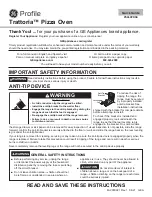
SilverCrest SDA 260 A1
16 - English
If necessary, check after a few hours whether the dehydration result is satisfactory.
Perform a touch test (see the recommended firmness in the tables from page 16) to
determine whether the food is already sufficiently dehydrated. If necessary, turn the food
and continue the dehydration process.
Risk of burns!
The lid (1), dehydration trays (2), and the base unit (4) become very hot during operation.
These also remain hot after the appliance is switched off. Therefore, be careful not to burn
yourself.
6. Pack the cooled dehydrated food. Ideally, use empty preserving jars or resealable jars that you may
have around the house. You can also shrink-wrap or vacuum-pack the food. The use of plastic bags is
not recommended. In theory, you can store your dehydrated food at any room temperature.
However, they will be preserved for longest if stored in a cool, dry and dark place.
7. Clean the dehydrator as described in the section "Maintenance/cleaning" on page 19.
Tips for good dehydration results
Do not dehydrate any food containing fat or oil (such as fatty meat or meat soaked in a
marinade that contained oil). Fat and oil becomes rancid during dehydration. Cream, milk and
butter have similar effects - please also avoid using them for marinades.
The dehydration times provided in the following are guideline values. The times may differ depending on
the quantity of dehydrated food, its thickness and size, etc.. At regular intervals, perform the
recommended touch test to determine whether the food is sufficiently dehydrated. If it is not sufficiently
dehydrated, continue dehydrating for a while longer.
Fruit
You can use dehydrated fruit as snacks or as ingredients for creative recipes. The fruit can be chopped
into small pieces, ground, or re-soaked.
If you are preparing fruit as snacks, do not dehydrate it for too long, otherwise it will become difficult to
chew.
Dehydrated fruit can be combined with nuts and cereals to create wonderful fruit muesli or yoghurt.
Before dehydration, dip the cut surfaces of fruit into lemon juice to prevent them from
turning brown.
To dehydrate stoned fruit, we recommend that you first dehydrate for approx. 2/3 of the
recommended time with the stone, and then remove the stone and separate the fruit for
the remaining dehydration time. Beginning the dehydration process makes it easier to
remove the stone.
Содержание SDA 260 A1
Страница 1: ......
Страница 2: ......
Страница 3: ...English 2 Polski 25 Magyar 51 Slovenščina 73 Čeština 95 Slovensky 117 Deutsch 139 V 1 4 ...
Страница 26: ...SilverCrest SDA 260 A1 24 English ...
Страница 52: ...SilverCrest SDA 260 A1 50 Polski ...















































